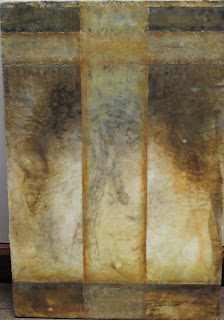. . and some encaustic paint
The next image of the above has some verticle lines at the top and bottom in grey oil stick and graphite oil stick . . .
BUT . . I didn't like these
I could have scraped them back (wax surface), but as they were rubbed into the surface and the underneath is a combination of wax medium and wax paint, I decided to go over the top ones in a warmer color . .
In this photo I toned down the brown in the top and bottom with clear encaustic medium and rubbed oil stick into the top vertical "lines" that were grey. I plan on "knocking" this back a lot, it's got "too much" for me.
The warmer oil stick I used looks like yellow . . but . . not in person. Coating an encaustic painting that has color on the surface with clear encaustic medium, depending on how thick of a coat is put on, starts to mute the surface. This is where much practice with applying the wax comes in. Too much wax will start to take the image away. Even though it's described as "clear" and is a vehicle for the paint, it is not totally clear when it's hardened (cold) . . kind of a slight haze. The beauty of working with this wax medium, to me, is that I can scrape back areas where the medium is too thick. It isn't easy to apply a smooth, thin coat of the medium. When I start a painting I have to decide how "bumpy" I will allow the surface to be, as I think of how I want it to look when finished. There are many, many decisions and techniques that are involved. But I love the tactile and reductive possibilities of this medium. It showed me how much I love process and actually showed me that I may get into assemblage at some point or perhaps a more 3 dimension surface.
I haven't worked on this next one as much as the one above. But I have decided where I will go next. This was the one I had used a tack iron on, then rubbed graphite oil stick into the surface.
This image shows some tan encaustic paint and more graphite oil stick.
The verticle section is encaustic paint and the hard edges are done with graphite oil stick. Anything that goes on the surface, from oil mediums to the wax paint and medium must be heated, or fused, into the surface that accepts it. I've found this is an art unto itself. It doesn't take much for the flame to alter the surface where no alteration is wanted!
I plan on muting the second horizontal line at the top as I explore altering the composition. Both will have one or more circles when done. To me, less is more, and it is a struggle for me to not add a "this" or a "that" . . "here" or "there."
Again . . just letting you in on the evolution of these two painting processes. In doing this, I realize I may risk the fact that what I consider as an unfinished surface may be more appealing than what the final result is. I consider this an exercise in artistic vulnerability . . something I value in other artists but find difficult to do. I've always been one to test the "edges of my safety zone". I so value vulnerability in others and the generosity of other artists sharing their process, that I have chosen to start pushing myself. :-)























































